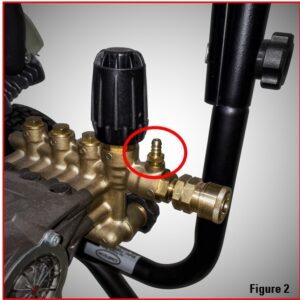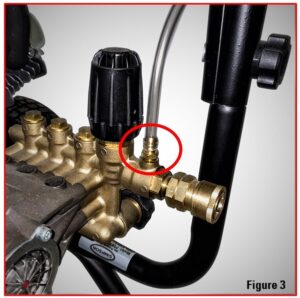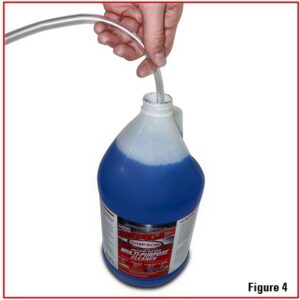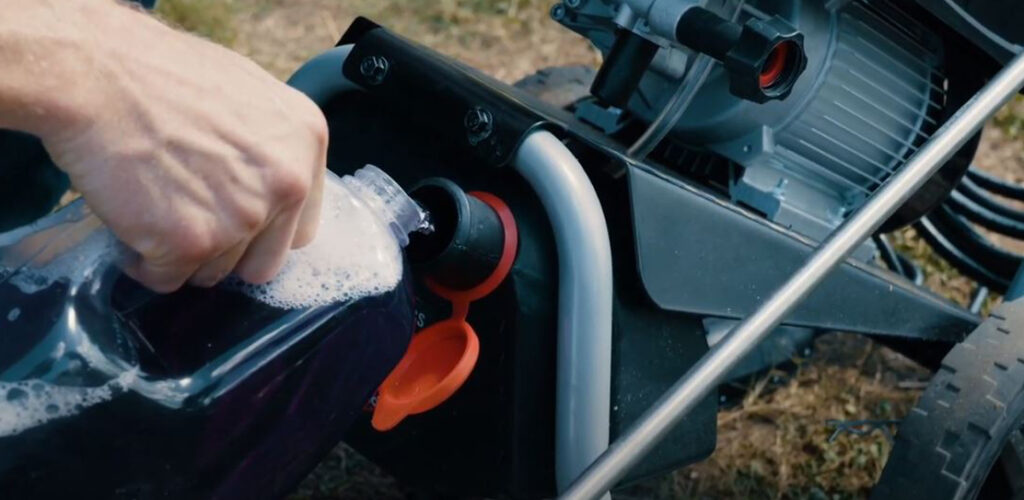One of the handiest features your pressure washer has is the ability to apply soap to the surface you are cleaning. Soap breaks down the bonds between dirt and the surface. While your pressure washer uses high pressure to clean, the use of soap makes for a faster job with a more uniform appearance. All pressure washers have the ability to inject soap. Some units have a dedicated tank attached to the frame while others need for you to use a bucket or just the bottle of soap itself.
Make sure to use detergents that are safe for use in pressure washers and never use bleach or flammable solvents. Applying cleaning detergents is a very easy process using one of the two following methods.
Soap/Detergent Tank
If you have a detergent tank attached to the frame of your pressure washer, simply remove the cap from the tank and pour the detergent into the tank. When you are done with your job, jump to Step 4 below, so you can clean out your soap system. If your detergent tank is not working properly, check out our troubleshooting post here.
Soap/Detergent Siphon Hose
Simply follow the steps below to utilize the soap feature on your pressure washer.
Step 1: Attach the siphon hose to the pump.

Where do I connect the siphon hose? On the pump, near the high-pressure output is a small brass barb. No matter what configuration of pump you have, the injection barb will always be on the output side of the pump (Fig. 2). Keep in mind that your pump may look slightly different than Figure 2.

How do I connect the siphon hose to the pump? If it is hard to slip the hose on the barb, you can use a light coating of soap to lubricate the barb allowing the hose to slide on easier. (Fig. 3)

Step 2: Choose a pressure washer safe detergent.
If you are using soap that is thick (thicker than water itself), you will need to dilute it with water. If you choose a detergent that is pressure washer safe, thinning should not be required. Never use anything caustic like bleach as the soap injection parts and pump may be damaged.
Step 3: Place the siphon hose into the soap container.
Place the filter end of the siphon hose directly into the bottle of soap (Fig. 4) or in a bucket with a soap/water mix.

Step 4: Start you job.
You are now ready to use your detergent with your pressure washer.
Be sure to use the (black) soap nozzle. When you want to apply soap, you need to use the (black) soap nozzle. The soap nozzle has a much larger orifice than a high-pressure nozzle. Only the soap nozzle will disperse soap; high-pressure nozzles will not.
Spray until you see soap. You will want to squeeze the trigger on the spray gun for a few moments until you see soap being dispersed.
How does the siphon hose work? When the pressure is low, the water passing by the soap barb creates a suction that opens the valve allowing the soap to be drawn into the system. While the water and soap move through the hose, they mix together. You apply the mixture to the surface just as you would wash it with the high-pressure spray.
Step 5: It is important to clean out the soap system after your job is done.
Why do I need to clean it out? Once you have completed using the soap system, you must clean it. The valve that the detergent filters through is very compact. If you do not flush the valve and the soap hose with a sufficient amount of clean water, the soap can harden inside the valve, keeping it from operating correctly in the future.
How do I clean out the soap system? Simply fill the tank with fresh water or, if you do not have a tank, fill a bucket with clean water then place the soap hose filter into the water. With the soap nozzle installed, spray water until all signs of soap are gone. This only takes a few minutes but will save you much aggravation in the future.
If you are having issues with your soap system, check out our troubleshooting post here.
